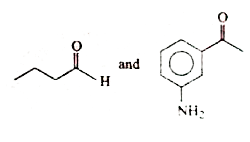A dihalogen derivative (A) of a hydrocarbon having two carbon atoms reacts with alcoholic potash and forms another hydrocarbon which gives a red precipitate with ammoniacal cuprous chloride. Compound A gives an aldehyde when treated with aqueous KOH. Write down the name and formula for the organic compound.
To solve the given problem, we need to identify the dihalogen derivative (A) of a hydrocarbon with two carbon atoms and analyze its reactions to find the final organic compound. Let's break this down step by step.
Step 1: Identify the Dihalogen Derivative (A)
The problem states that compound A is a dihalogen derivative of a hydrocarbon with two carbon atoms. The simplest dihalogen derivative with two carbon atoms is 1,1-dichloroethane.
Structure of 1,1-dichloroethane:
Cl|H3C−C−CH3|Cl
Step 2: Reaction with Alcoholic Potash
When 1,1-dichloroethane reacts with alcoholic potash (alcoholic KOH), it undergoes dehydrohalogenation, leading to the formation of an alkyne. The expected product from this reaction is ethyne (acetylene).
Reaction:
\( \text{1,1-dichloroethane} + \text{alcoholic KOH} \rightarrow \text{ethyne} + \text{HCl} \)
Step 3: Ethyne and Ammoniacal Cuprous Chloride
Ethyne (C2H2) reacts with ammoniacal cuprous chloride (CuCl in the presence of liquid ammonia) to form a red precipitate of cuprous acetylide.
Reaction:
\( \text{C2H2} + \text{CuCl} \rightarrow \text{CuC} \equiv \text{C} + \text{HCl} \)
This confirms that the product gives a red precipitate with ammoniacal cuprous chloride.
Step 4: Reaction of Compound A with Aqueous KOH
When 1,1-dichloroethane is treated with aqueous KOH, it undergoes hydrolysis to form an aldehyde. The product formed is acetaldehyde (ethanal).
Reaction:
\( \text{1,1-dichloroethane} + \text{aqueous KOH} \rightarrow \text{acetaldehyde} + \text{HCl} + \text{H2O} \)
Final Answer
Based on the above reactions, we conclude that:
- The dihalogen derivative (A) is 1,1-dichloroethane.
- The aldehyde formed is acetaldehyde.
Summary
- Compound A: 1,1-dichloroethane (C2H4Cl2)
- Aldehyde formed: Acetaldehyde (C2H4O)
The problem states that compound A is a dihalogen derivative of a hydrocarbon with two carbon atoms. The simplest dihalogen derivative with two carbon atoms is 1,1-dichloroethane.
Cl|H3C−C−CH3|Cl
When 1,1-dichloroethane reacts with alcoholic potash (alcoholic KOH), it undergoes dehydrohalogenation, leading to the formation of an alkyne. The expected product from this reaction is ethyne (acetylene).
\( \text{1,1-dichloroethane} + \text{alcoholic KOH} \rightarrow \text{ethyne} + \text{HCl} \)
Ethyne (C2H2) reacts with ammoniacal cuprous chloride (CuCl in the presence of liquid ammonia) to form a red precipitate of cuprous acetylide.
\( \text{C2H2} + \text{CuCl} \rightarrow \text{CuC} \equiv \text{C} + \text{HCl} \)
When 1,1-dichloroethane is treated with aqueous KOH, it undergoes hydrolysis to form an aldehyde. The product formed is acetaldehyde (ethanal).
\( \text{1,1-dichloroethane} + \text{aqueous KOH} \rightarrow \text{acetaldehyde} + \text{HCl} + \text{H2O} \)
Based on the above reactions, we conclude that:
- The dihalogen derivative (A) is 1,1-dichloroethane.
- The aldehyde formed is acetaldehyde.
- Compound A: 1,1-dichloroethane (C2H4Cl2)
- Aldehyde formed: Acetaldehyde (C2H4O)
Topper's Solved these Questions
- ALKYNESBOOK - CENGAGE CHEMISTRY ENGLISHCHAPTER - ALKYNESEXERCISE - Exercises (Linked Comprehension Type)
51 Videos
- ALKYNESBOOK - CENGAGE CHEMISTRY ENGLISHCHAPTER - ALKYNESEXERCISE - Exercises (Multiple Correct Answers Type)
25 Videos
- ALKYNESBOOK - CENGAGE CHEMISTRY ENGLISHCHAPTER - ALKYNESEXERCISE - Solved Examples
24 Videos
- ALKENES AND ALKADIENESBOOK - CENGAGE CHEMISTRY ENGLISHCHAPTER - ALKENES AND ALKADIENESEXERCISE - Single correct Answer
14 Videos
- APPENDIX - INORGANIC VOLUME 1BOOK - CENGAGE CHEMISTRY ENGLISHCHAPTER - APPENDIX - INORGANIC VOLUME 1EXERCISE - chapter-7 Single correct answer
1 Video
Similar Questions
Name a hydrocarbon which will form a red precipitate with ammoniacal solution of copper (I) chloride.
View SolutionThe unsaturated hydrocarbon obtained by the reaction of a dihalogen derivative with alcoholic potash gives a red precipitate with ammoniacal cuprous chloride. The dihalogen derivative gives propanal on heating with aqueous potash. The dihalogen derivative is:
View Solution
Knowledge Check
A hydrocarbon (A) on chlorination gives (B), wich on reacting with alcoholic KOH changes into another hydrocarbon (c). The latter decolorizes Baeyer's reagent and on ozonolysis forms formaldehyde only (A) is :
AMethaneBEtheneCEthaneDButaneA mixture of two organic compound gives red coloured precipitate with cuprous chloride and silver mirror on heating with Zn and NH4Cl followed by AgNO3+NH4OH solution. The mixture contains :
A B
B C
C D
D
An organic compound undergoes addition reactions and gives a red precipitate with ammoniacal cuprous chloride. Therefore, the organic compound could be:
View SolutionWith alcoholic potash, C4H8Cl2 (A) gives C4H6 (B), which reacts with ammoniacal cuprous chloride. Identify the compounds (A) and (B).
View SolutionFrom the list of the organic compounds ethanol, ethane, methanol, methane, ethyne and ethane, name a compound
Which will give red precipitate with ammoniacal copper (I) chloride solution.
View SolutionA dihalogen derivative (A) with three C-atoms gives a hydrocarbon (B) on reacting with alc KOH. (B) gives a white precipitate with Tollen’s reagent. (A) on heating with aqueous KOH gives a ketone. Compound (A) is:
View SolutionA chloro compound (A) showed the following properties,
i. decolourised bromine in CCl4
(ii). Absorbed hydrogen catalytically.
(iii). Gave a red precipitate with ammoniacal cuprous chloride
(iv). When vaporised 1.49 gm of (A) gave 448 ml of vapours at STP. Identify (A) and write the equation for the reaction is step 3.
View SolutionWhen phenol is treated with bromine water, white precipitate is obtained. Give the structure and the name of the compound formed.
View Solution